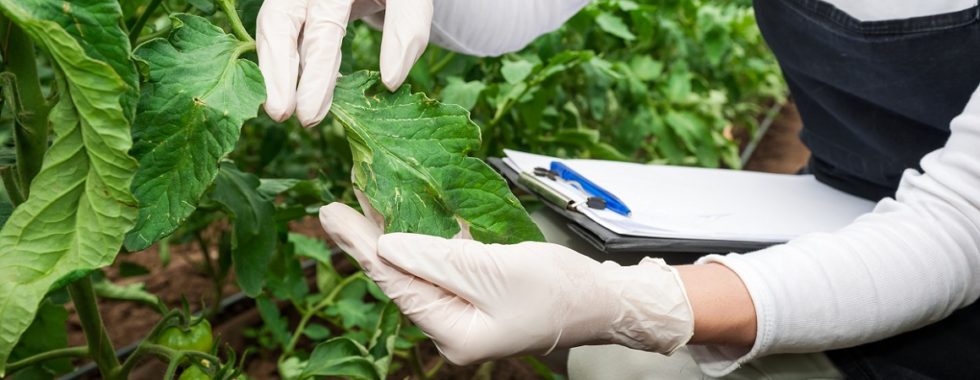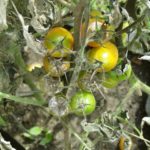Plant diseases
What is a plant disease?
A plant disease is defined as abnormal growth of the plant, or interference with the normal function of the plant.
3 conditions must exist in order for a disease do develop:
- There must be a host plant, i.e. the plant has to be susceptible to the disease.
- A pathogen (virus, bacteria, fungus or parasite) must reach the host.
- The environmental conditions must be favorable for the development of the disease.
Cultural practices can affect, to some extent, some of the above conditions.
An important part of the identification process is having a thorough knowledge of :
- The conditions that might lead to the occurrence of the disease.
- The susceptibility of the plant.
- Common symptoms and signs.
- The disease life cycle.
- The environmental conditions that the disease favors.
SIGNS AND SYMPTOMS
Diseases have symptoms and causes, and in some cases may also have signs.
Signs are an actual, physical evidence of the pathogen. For example, spores of powdery mildew, mycelial growth of Sclerotinia Sclerotiorum.
Symptoms are abnormal changes in the plant growth or appearance.
Examples of symptoms:
- Leaf yellowing, discoloration
- Leaf spots
- Spores on leaves (white, black, brownish)
- Wilting
- Stem rot
- Fruit distortion
- Leaf curling, distortion
- Necrosis
- Fruit rot
- Root rot
- Canker
- Stunted plant
It is important to keep in mind that different plants may express different symptoms in a response to the same pathogen and vice versa – many symptoms are not specific and can occur as a response to different causes.
Many times, symptoms caused by biotic and abiotic causes can appear very similar.
For example, wilting can be a result of lack of water or a result of root/stem disease.
PLANT DISEASE CAUSES
Note that Symptom ≠ Cause.
Symptoms can be a result of biotic (living organisms) or abiotic causes.
When the cause is biotic, we call it a Disease.
When the cause is abiotic, we usually refer to it as a Disorder.
Abiotic causes include temperature, wind, chemical damage from a pesticide, nutritional deficiencies, salinity, overwatering etc. Abiotic causes can lead to a disease, by weakening the plant and making it more vulnerable to pathogens and therefore more susceptible to diseases.
Biotic causes include fungi, bacteria viruses and nematodes.
Identifying the cause is essential in order to be successful in disease management. In many cases, a combination of causes occur, what makes the identification more complex. Once one disease occurs, it is easier for other secondary diseases, to attack the plant. Therefore, it is important to identify the primary and secondary causes.
Damage caused by an abiotic cause, does not spread from plant to plant.
Diseases which have a biotic cause, can spread to adjacent plants and even to plants that are far apart (e.g.by pests, wind, water, tools and cloths).
Examples of fungal diseases with symptoms on leaves:
|
Common Name |
Scientific Name | Host |
|
Downy mildew |
Various, Perenospora |
Lettuce, onion, brassicas, roses, cucurbits, pea, spinach, ornamentals |
|
Late blight |
Phytophtora infestans |
Tomato, potato |
|
White rust |
Albugo candida |
Brassicas – cabbage, radish, turnips, cauliflower, broccoli, brussels sprouts |
|
Anthracnose |
Colletotrichum fragariae |
Strawberry |
|
Botrytis |
Botrytis cinerea |
Wide range |
|
Tomato early blight |
Alternaria solani |
Potato, tomato |
|
Septoria leaf spot |
Septoria lycopersici | Tomato, eggplant, potato |
|
Powdery mildew |
Various- host specific |
Wide range |
| Verticillium wilt | Verticillium |
Wide range, tomato |
| Rusts | Pucciniales |
Wide range |
Examples of fungal diseases that affect roots and crown
|
Common Name |
Scientific Name |
Host |
|
Fusarium wilt, F. root rot |
Fusarium oxysporu, F. solani |
Wide range of vegetables and flowers |
|
Verticillium wilt |
Verticillium |
Wide range of crops, tomato |
|
Rhizoctonia root rot |
Rhizoctonia solani and others |
Wide range |
|
Pythium |
Pythium spp. |
Wide range |
Examples of bacterial diseases:
|
Bacteria |
Common diseases |
|
Agrobacterium |
Crown Gall disease |
|
Clavibacter |
Bacterial canker (tomato) |
|
Erwinia |
Bacterial rot |
|
Pseudomonas |
Bacterial leaf spot, bacterial soft rot, bacterial blight |
|
Ralstonia |
Bacterial wilts |
|
Xanthomonas |
Bacterial wilts, leaf spot, bacterial blight |






